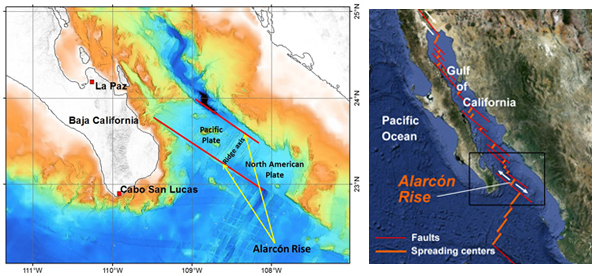Geologists have discovered that some strange things are happening off the southern coast of the Baja California Peninsula.
In essence, while most of Mexico rests on the North American plate, the Baja California Peninsula is on the gigantic Pacific plate. The Pacific plate is moving slowly northwest and the pressures in the zone where these two plates intersect, under the Sea of Cortés (Gulf of California), has caused a complex series of parallel faults which (further north) link to the California’s San Andreas Fault system. Thus, the Sea of Cortés is an area of heavy seismic activity.
The Alarcón Rise (see map) is a 50km (30 mi) long “bump” under the Sea of Cortés. New seafloor is being continuously created along the Alarcón Rise as undersea magma rises to the surface and cools to become lava. As the plates continue to move, this lave is then carried away to either side of the Alarcón Rise, allowing fresh lava to take its place, and so on. The rate of sea-floor spreading here is a relatively slow 5 cm (2 in) a year.
The Alarcón Rise has been studied in considerable detail by geologists attached to the Monterey Bay Aquarium Research Institute (MBARI) in California. Using a sonar-mapping robot, they discovered new deep-sea hydrothermal vents.
But their most surprising find was a “Weird Underwater Volcano.”
In most zones of sea-floor spreading, the lavas are relatively low in silica and therefore free-flowing. Such lavas are known, on account of their chemistry, as “basic” lavas. (Lavas higher in silica, known collectively as acid lavas, tend to be more viscous and flow less easily. Acid lava volcanoes tend to erupt far more explosively than basic lava volcanoes.)
The curiosity of the Alarcón Rise is that while the vast majority of lava flows along the ridge are basic (basalt) lavas, those associated with at least one volcano are clearly acidic, not basic.
Researchers used a remote-control vehicle to collect samples and explore the volcano, which is 2375 m (7800 ft) below the surface. Samples of the lava show that it is primarily rhyolite with some dacite, with a silica content of up to 77%, the highest of any rock ever found along a mid-ocean ridge, according to Brian Dreyer, a geochemist at the University of California, Santa Cruz. The volcano with acid lava forms a small dome, about 50 meters (165 ft) in height and covers an area of about 1200 meters by 500 meters (4000 feet by 1640 feet). The dome is probably several thousand years old.
The lavas solidified quickly to form angular chunky blocks, some of which then rolled down the sides of the rise to form talus (scree). The individual blocks can be as large as cars or small houses.
The findings suggest that this particular volcano could give rise to hazardous eruptions. It is only 100 km (60 mi) from land and very close to the major tourist areas fringing the coast of Baja California Sur. Any major explosive eruption from this volcano could also cause a tsunami with the potential to devastate settlements on both coasts of the Sea of Cortés (Gulf of California).
Geologists are still working on trying to fully explain this apparent anomaly in lava composition. They have already discarded several ideas, and their current hypothesis is that the magma source was at some point contaminated by seawater, resulting in an unusually high concentration of volatiles such as water, sulfur and chlorine.
Related posts:

Sorry, the comment form is closed at this time.